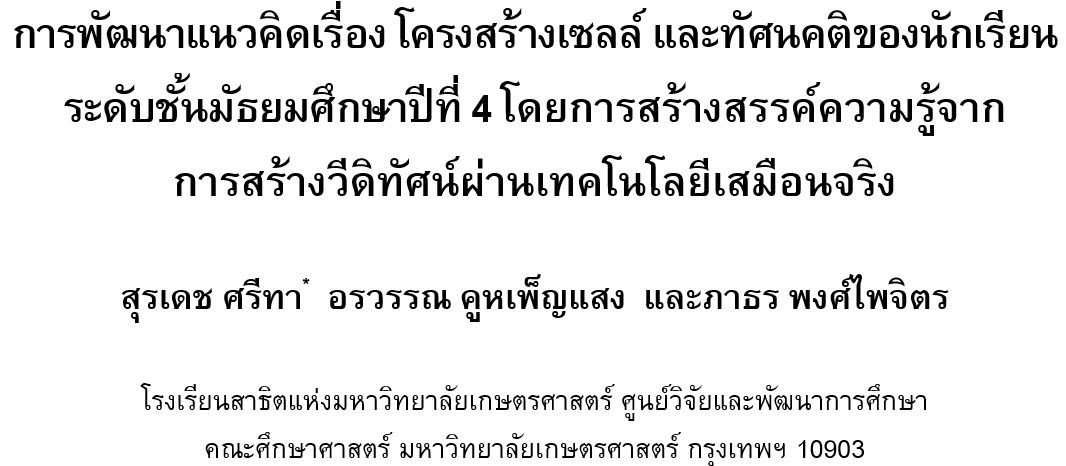การพัฒนาแนวคิดเรื่อง โครงสร้างเซลล์ และทัศนคติของนักเรียนระดับชั้นมัธยมศึกษาปีที่ 4 โดยการสร้างสรรค์ความรู้จากการสร้างวีดิทัศน์ผ่านเทคโนโลยีเสมือนจริง
Main Article Content
Abstract
Suradet Sritha, Orawan Kuhapensang and Partorn Phongpijit
รับบทความ: 18 กุมภาพันธ์ 2560; ยอมรับตีพิมพ์: 30 ตุลาคม 2560
บทคัดย่อ
งานวิจัยครั้งนี้มีวัตถุประสงค์เพื่อส่งเสริมแนวคิดวิทยาศาสตร์เรื่อง โครงสร้างเซลล์ โดยการสร้างสรรค์ความรู้จากการสร้างวีดิทัศน์ผ่านเทคโนโลยีเสมือนจริง และศึกษาทัศนคติของนักเรียนที่มีต่อกิจกรรมการเรียนรู้โดยการสร้างสรรค์ความรู้จากการสร้างวีดิทัศน์ผ่านเทคโนโลยีเสมือนจริงที่สามารถส่งเสริมแนวคิดวิทยาศาสตร์เรื่องโครงสร้างเซลล์ของนักเรียนชั้นมัธยมศึกษาปีที่ 4 กลุ่มที่ศึกษาเป็นนักเรียนระดับชั้นมัธยมศึกษาปีที่ 4 ปีการศึกษา 2559 แผนการเรียนวิทยาศาสตร์และเทคโนโลยี ของโรงเรียนสังกัดสำนักงานการอุดมศึกษา จำนวน 219 คน เครื่องมือที่ใช้ในการวิจัย คือ แผนการจัดการเรียนรู้รายหน่วยเรื่อง โครงสร้างเซลล์ จำนวน 6 คาบเรียน และเครื่องมือที่ใช้ในการเก็บข้อมูล ได้แก่ แบบวัดแนวคิดวิทยาศาสตร์ก่อนและหลังเรียน จำนวน 9 ข้อ แบบบันทึกหลังสอนของครู แบบบันทึกการเรียนรู้ของนักเรียน วิเคราะห์ข้อมูลโดยการนับความถี่ของกลุ่มคำตอบและหาค่าร้อยละ และการวิเคราะห์เนื้อหา ผลการวิจัยพบว่า 1) นักเรียนมีแนวคิดวิทยาศาสตร์ โดยแนวคิดวิทยาศาสตร์แบบไม่สมบูรณ์หลังเรียนสูงกว่าก่อนเรียนในทุกแนวคิด 2) นักเรียนมีทัศนคติที่ดีต่อการเรียน โดยนักเรียนส่วนใหญ่แสดงความคิดเห็นว่าการสร้างสรรค์ความรู้จากการสร้างวีดิทัศน์ผ่านเทคโนโลยีเสมือนจริงทำให้การเรียนการสอนในห้องเรียนมีความน่าสนใจมากขึ้น มีความตระหนักในการนำเทคโนโลยีที่ทันสมัยมาใช้ในการเรียนรู้ การทำกิจกรรมช่วยทำให้ได้ความรู้มากกว่าการเรียนแบบปกติ และได้ฝึกการทำงานอย่างเป็นระบบและการทำงานเป็นทีม
คำสำคัญ: แนวคิดวิทยาศาสตร์เรื่องโครงสร้างเซลล์ การสร้างสรรค์ความรู้ผ่านชิ้นงาน เทคโนโลยีเสมือนจริง
Abstract
The purposes of this study were to promote the scientific concept of the cell structures with the augment reality video and to investigate the attitudes of the students towards the learning activity with the video. The students were 219 grade–10 students in the academic year of 2016 in the science and technology study plan of the schools under the Office of the Higher Education. The research instrument was the cell structure study plan with six sessions. The data collection instruments were the pre– and post–study scientific conception evaluation forms with nine items, post-teaching record form, and students' learning record form. The data were analyzed calculating the frequencies and percentages of the answers. The content analysis was also conducted. The findings were as follows. Firstly, the students after learning had higher incomplete scientific perceptions than those before learning in all aspects. Secondly, the students had good attitudes towards the study. Most students thought that learning from the video made the classrooms interesting. They were aware of using the technologies for the learning purpose in order to improve their learning capacities and practice teamwork.
Keywords: Scientific concepts of Cell structures, Constructionism approach, Augmented reality
Downloads
Article Details

This work is licensed under a Creative Commons Attribution-NonCommercial 4.0 International License.
References
Anugoonsawat, W., Ketsing, J., and Anuntasethkul, T. (2012). Grade 11 Students’ Conceptions of Cell and Cell Structure. Proceedings of 50th Kasetsart University Annual Conference: Education, Economics and Business Administration, Humanities and Social Sciences. Bangkok: Kasetsart University. (in Thai)
Bimbola, O., and Daniel, O. (2010). Effect of constructivist-based teaching strategy on academic performance of students in integrated science at the junior Secondary school level. Educational Research and Reviews 5 (7): 347–353.
Chocchai, L. (2014). The Development of 7th Grade Students’ Conception about Cells by Model-Based Learning Activities. Master’s Thesis. Bangkok: Kasetsart University. (in Thai)
Chueamek, K., Phibanchon, S., and Srisanyong, S. (2016). The achievement of teaching in biology and student’s attitude in the constructionism approach for 10th grade students. Journal of Education Naresuan University 18(4): 171–182 (in Thai)
Doomhom, J. (2010). The Effect of Inquiry-Based Learning on Development of Concepts and Attitudes towards Learning on Cells and Cell Division of Grade 10th Students. Master’s Thesis. Bangkok: Kasetsart University. (in Thai)
Greene, H., and Crespi, C. (2012). The value of student created videos tn the college classroom – An exploratory study in marketing and accounting. International Journal of Arts & Sciences 5(1): 273–283.
Haidar, A. H. (1997). Prospective chemistry teachers’ conception of conservation of matter and related concepts. Journal of Research in Science Teaching 34(4): 181–197.
Khammani, T. (2011). Science Teaching. 12th ed. Bangkok: Dantsuta Printing. (in Thai)
Lee, K. (2012). Augmented reality in education and training. TechTrends 56(2): 13–21.
Ministry of Education (2008). Core Curriculum for Basic Education Act 2551. [Online]. Retrieved from http://lowersecondarymath.ipst.ac.th/wp-content/uploads/2015/PDF/Curriculum%202551.pdf, June 3, 2016. (in Thai)
Nuchropom, N. (2011). The development of creative learning skills through computer medias by using constructionism of Phathomsuksa 6 students, Kasetsart University Laboratory School Center for Educational Research and Development. Kasetsart Educational Review 27(1): 13–25 (in Thai)
Office of the National Education Commission [ONEC]. (2002). The National Education Act B.E.2542 and Amendments (the Second National Education Act B.E. 2545 (2002). Bangkok: International Relations and Cooperation Center for Educational Reform. (in Thai)
Promso, C., Saejueng, P., and Wuttisela, K. (2015). Study on normalized learning gains and concepts of molecular shape and polar covalent bond learning through augmented reality technology. Journal of Research Unit on Science, Technology and Environment for Learning 6(1): 57– 69. (in Thai)
Sripha, P. (2013). Production of the New Teaching Materials by AURASMA. [Online]. Retrieved from http://www.slideshare.net/cas, June 3, 2016. (in Thai)
Techakosit, S. (2015). Augmented reality technology in physics education. Knowledge sharing with Science Teachers. Bangkok: Siam Print. (in Thai)
Techakosit, S. and Piriyasurawong, P. (2015). Constructionist learning and teaching using augmented reality technology for science subject. Technical Education Jour-nal King Mongkut’s University of Technology North Bangkok 6(1): 225–230 (in Thai)
Thunhikorn, B. (2010). The Application of Information Technology in Learning. 2nd ed. Bangkok: Agriculture Cooperatives of Thailand. (in Thai)
Toraman, C., and Demir, E. (2016). The effect of constructivism on attitudes towards lessons: A meta–analysis study. Eurasian Journal of Educational Research 62: 115–142.
Tunsiri, P. (2010). Augmented Reality. BU Executive Journal 30(2): 169–175. (in Thai)
Tyler, R. (2002). Learning for understanding in science: Constructivism/conceptual change model in science teacher education. Science Education 80: 317–341.
Xerou, E., Papadima-Sophocleous, S., and Parmaxi, A. (2016). A social constructionist approach to teaching and learning vocabulary for Italian for academic purposes. EUROCALL 2016: 485-489 [Online]. Retrieved from https://doi.org/10.14705/rpnet.2016.eurocall2016.611, October 16, 2017.
